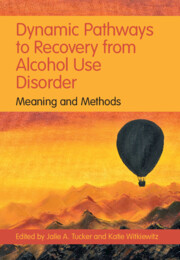Book contents
- Dynamic Pathways to Recovery from Alcohol Use Disorder
- Dynamic Pathways to Recovery from Alcohol Use Disorder
- Copyright page
- Dedication
- Contents
- Figures
- Tables
- Contributors
- Foreword
- Preface
- Acknowledgments
- Introduction
- Part I Micro Level
- Part II Meso Level
- Part III Macro Level
- 16 Recovery Communities
- 17 Disparities in Alcohol Treatment Access in Rural Areas
- 18 Recovery, Communities, and the Organized Recovery Movement
- 19 Alcohol Control Policy and Regulations to Promote Recovery from Alcohol Use Disorder
- 20 Causal Inference Approaches to Studying Recovery from Alcohol Use Disorder
- 21 Building on Collaborative Research to Co-Design SURE Recovery, a Mobile Application for People with Experience of Alcohol and Other Drug Problems
- 22 Economic Methods Used to Evaluate Recovery Programs for Alcohol Use Disorder
- Conclusions and Future Directions
- Index
- References
21 - Building on Collaborative Research to Co-Design SURE Recovery, a Mobile Application for People with Experience of Alcohol and Other Drug Problems
from Part III - Macro Level
Published online by Cambridge University Press: 23 December 2021
- Dynamic Pathways to Recovery from Alcohol Use Disorder
- Dynamic Pathways to Recovery from Alcohol Use Disorder
- Copyright page
- Dedication
- Contents
- Figures
- Tables
- Contributors
- Foreword
- Preface
- Acknowledgments
- Introduction
- Part I Micro Level
- Part II Meso Level
- Part III Macro Level
- 16 Recovery Communities
- 17 Disparities in Alcohol Treatment Access in Rural Areas
- 18 Recovery, Communities, and the Organized Recovery Movement
- 19 Alcohol Control Policy and Regulations to Promote Recovery from Alcohol Use Disorder
- 20 Causal Inference Approaches to Studying Recovery from Alcohol Use Disorder
- 21 Building on Collaborative Research to Co-Design SURE Recovery, a Mobile Application for People with Experience of Alcohol and Other Drug Problems
- 22 Economic Methods Used to Evaluate Recovery Programs for Alcohol Use Disorder
- Conclusions and Future Directions
- Index
- References
Summary
A collaborative research approach was used to co-develop patient reported outcome measures or PROMS. One of our PROMS (SURE) assesses recovery from alcohol and other drug problems, and another (SUSS) assesses sleep problems. People using SURE and SUSS reported that they would like to complete them on their mobile phones and tablet computers so that they could record and refer back to their scores. This chapter describes the collaborative research process used to co-design a mobile application (app) called SURE Recovery, including the experiences of working with a diverse team of people with lived experience of addiction, researchers, app developers, and clinicians. The chapter also provides reflections on the challenges encountered and the lessons learned. Insights and advice for others are offered who might be interested in developing similar recovery-oriented apps in the future.
Keywords
- Type
- Chapter
- Information
- Dynamic Pathways to Recovery from Alcohol Use DisorderMeaning and Methods, pp. 380 - 399Publisher: Cambridge University PressPrint publication year: 2022



